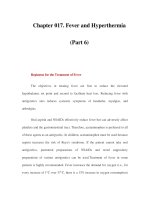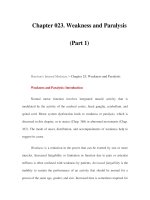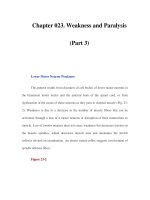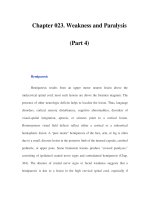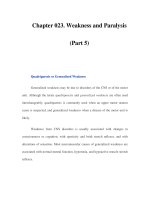Chapter 023. Weakness and Paralysis (Part 6) pps
Bạn đang xem bản rút gọn của tài liệu. Xem và tải ngay bản đầy đủ của tài liệu tại đây (12.63 KB, 5 trang )
Chapter 023. Weakness and Paralysis
(Part 6)
Acute Monoparesis
If the weakness is predominantly in distal and nonantigravity muscles and
not associated with sensory impairment or pain, focal cortical ischemia is likely
(Chap. 364); diagnostic possibilities are similar to those for acute hemiparesis.
Sensory loss and pain usually accompany acute lower motor neuron
weakness; the weakness is commonly localized to a single nerve root or peripheral
nerve within the limb but occasionally reflects plexus involvement. If lower motor
neuron weakness is suspected, or the pattern of weakness is uncertain, the clinical
approach begins with an EMG and nerve conduction study.
Subacute or Chronic Monoparesis
Weakness and atrophy that develop over weeks or months are usually of
lower motor neuron origin. If they are associated with sensory symptoms, a
peripheral cause (nerve, root, or plexus) is likely; in the absence of such
symptoms, anterior horn cell disease should be considered. In either case, an
electrodiagnostic study is indicated. If weakness is of upper motor neuron type, a
discrete cortical (precentral gyrus) or cord lesion may be responsible, and an
imaging study is performed of the appropriate site.
Distal Weakness
Involvement of two or more limbs distally suggests lower motor neuron or
peripheral nerve disease. Acute distal lower limb weakness occurs occasionally
from an acute toxic polyneuropathy or cauda equina syndrome.
Distal symmetric weakness usually develops over weeks, months, or years
and, when associated with numbness, is due to metabolic, toxic, hereditary,
degenerative, or inflammatory diseases of peripheral nerves (Chap. 379). Anterior
horn cell disease may begin distally but is typically asymmetric and without
accompanying numbness (Chap. 369). Rarely, myopathies present with distal
weakness (Chap. 382). Electrodiagnostic studies help to localize the disorder (Fig.
23-3).
Proximal Weakness
Myopathy often produces symmetric weakness of the pelvic or shoulder
girdle muscles (Chap. 382). Diseases of the neuromuscular junction [such as
myasthenia gravis (Chap. 381)], may present with symmetric proximal weakness
often associated with ptosis, diplopia, or bulbar weakness and fluctuating in
severity during the day.
Extreme fatigability present in some cases of myasthenia gravis may even
suggest episodic weakness, but strength rarely returns fully to normal. In anterior
horn cell disease proximal weakness is usually asymmetric, but may be symmetric
if familial.
Numbness does not occur with any of these diseases. The evaluation
usually begins with determination of the serum creatine kinase level and
electrophysiologic studies.
Weakness in a Restricted Distribution
Weakness may not fit any of the above patterns, being limited, for example,
to the extraocular, hemifacial, bulbar, or respiratory muscles. If unilateral,
restricted weakness is usually due to lower motor neuron or peripheral nerve
disease, such as in a facial palsy (Chap. 379) or an isolated superior oblique
muscle paresis (Chap. 382).
Weakness of part of a limb is usually due to a peripheral nerve lesion such
as carpal tunnel syndrome or another entrapment neuropathy. Relatively
symmetric weakness of extraocular or bulbar muscles is usually due to a myopathy
(Chap. 382) or neuromuscular junction disorder (Chap. 381). Bilateral facial palsy
with areflexia suggests Guillain-Barré syndrome (Chap. 380). Worsening of
relatively symmetric weakness with fatigue is characteristic of neuromuscular
junction disorders. Asymmetric bulbar weakness is usually due to motor neuron
disease. Weakness limited to respiratory muscles is uncommon and is usually due
to motor neuron disease, myasthenia gravis, or polymyositis/dermatomyositis
(Chap. 383).
Acknowledgment
Richard K. Olney, MD, was the author of this chapter in previous editions,
and his contributions in the last three editions of Harrison's are appreciated
